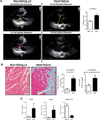Mechanical unloading promotes myocardial energy recovery in human heart failure
- PMID: 24825877
- PMCID: PMC4394989
- DOI: 10.1161/CIRCGENETICS.113.000404
Mechanical unloading promotes myocardial energy recovery in human heart failure
Abstract
Background: Impaired bioenergetics is a prominent feature of the failing heart, but the underlying metabolic perturbations are poorly understood.
Methods and results: We compared metabolomic, gene transcript, and protein data from 6 paired samples of failing human left ventricular tissue obtained during left ventricular assist device insertion (heart failure samples) and at heart transplant (post-left ventricular assist device samples). Nonfailing left ventricular wall samples procured from explanted hearts of patients with right heart failure served as novel comparison samples. Metabolomic analyses uncovered a distinct pattern in heart failure tissue: 2.6-fold increased pyruvate concentrations coupled with reduced Krebs cycle intermediates and short-chain acylcarnitines, suggesting a global reduction in substrate oxidation. These findings were associated with decreased transcript levels for enzymes that catalyze fatty acid oxidation and pyruvate metabolism and for key transcriptional regulators of mitochondrial metabolism and biogenesis, peroxisome proliferator-activated receptor γ coactivator 1α (PGC1A, 1.3-fold) and estrogen-related receptor α (ERRA, 1.2-fold) and γ (ERRG, 2.2-fold). Thus, parallel decreases in key transcription factors and their target metabolic enzyme genes can explain the decreases in associated metabolic intermediates. Mechanical support with left ventricular assist device improved all of these metabolic and transcriptional defects.
Conclusions: These observations underscore an important pathophysiologic role for severely defective metabolism in heart failure, while the reversibility of these defects by left ventricular assist device suggests metabolic resilience of the human heart.
Keywords: heart failure; metabolism; mitochondria.
© 2014 American Heart Association, Inc.
Conflict of interest statement
Figures





Similar articles
-
The Role of Nonglycolytic Glucose Metabolism in Myocardial Recovery Upon Mechanical Unloading and Circulatory Support in Chronic Heart Failure.Circulation. 2020 Jul 21;142(3):259-274. doi: 10.1161/CIRCULATIONAHA.119.044452. Epub 2020 Apr 30. Circulation. 2020. PMID: 32351122 Free PMC article.
-
Ventricular assist device implantation corrects myocardial lipotoxicity, reverses insulin resistance, and normalizes cardiac metabolism in patients with advanced heart failure.Circulation. 2012 Jun 12;125(23):2844-53. doi: 10.1161/CIRCULATIONAHA.111.060889. Epub 2012 May 14. Circulation. 2012. PMID: 22586279 Free PMC article.
-
Reduced Myocardial Mitochondrial ROS Production in Mechanically Unloaded Hearts.J Cardiovasc Transl Res. 2019 Apr;12(2):107-115. doi: 10.1007/s12265-018-9803-3. Epub 2018 Mar 27. J Cardiovasc Transl Res. 2019. PMID: 29589269
-
Mitochondrial Bioenergetics and Dysfunction in Failing Heart.Adv Exp Med Biol. 2017;982:65-80. doi: 10.1007/978-3-319-55330-6_4. Adv Exp Med Biol. 2017. PMID: 28551782 Review.
-
Left ventricular assist device-induced molecular changes in the failing myocardium.Curr Opin Cardiol. 2008 May;23(3):206-18. doi: 10.1097/HCO.0b013e3282fc7010. Curr Opin Cardiol. 2008. PMID: 18382208 Review.
Cited by
-
Clinical indications and outcomes of Impella devices for severe cardiogenic shock in COVID-19 patients: a systematic review.Ann Med Surg (Lond). 2023 Nov 1;85(12):6115-6122. doi: 10.1097/MS9.0000000000001425. eCollection 2023 Dec. Ann Med Surg (Lond). 2023. PMID: 38098597 Free PMC article. Review.
-
Mass Spectrometric Analysis of L-carnitine and its Esters: Potential Biomarkers of Disturbances in Carnitine Homeostasis.Curr Mol Med. 2020;20(5):336-354. doi: 10.2174/1566524019666191113120828. Curr Mol Med. 2020. PMID: 31729298 Free PMC article. Review.
-
Mechanical Unloading by Fulminant Myocarditis: LV-IMPELLA, ECMELLA, BI-PELLA, and PROPELLA Concepts.J Cardiovasc Transl Res. 2019 Apr;12(2):116-123. doi: 10.1007/s12265-018-9820-2. Epub 2018 Aug 6. J Cardiovasc Transl Res. 2019. PMID: 30084076 Free PMC article. Review.
-
SGLT2 inhibitors: role in protective reprogramming of cardiac nutrient transport and metabolism.Nat Rev Cardiol. 2023 Jul;20(7):443-462. doi: 10.1038/s41569-022-00824-4. Epub 2023 Jan 6. Nat Rev Cardiol. 2023. PMID: 36609604 Review.
-
Performance of a cardiac lipid panel compared to four prognostic scores in chronic heart failure.Sci Rep. 2021 Apr 14;11(1):8164. doi: 10.1038/s41598-021-87776-w. Sci Rep. 2021. PMID: 33854188 Free PMC article.
References
-
- Jhund PS, Macintyre K, Simpson CR, Lewsey JD, Stewart S, Redpath A, et al. Long-term trends in first hospitalization for heart failure and subsequent survival between 1986 and 2003: a population study of 5.1 million people. Circulation. 2009;119:515–523. - PubMed
-
- Zannad F, McMurray JJ, Krum H, van Veldhuisen DJ, Swedberg K, Shi H, et al. Eplerenone in patients with systolic heart failure and mild symptoms. N Engl J Med. 2011;364:11–21. - PubMed
-
- Stewart S, Ekman I, Ekman T, Oden A, Rosengren A. Population impact of heart failure and the most common forms of cancer: a study of 1 162 309 hospital cases in Sweden (1988 to 2004) Circ Cardiovasc Qual Outcomes. 2010;3:573–580. - PubMed
-
- Estep JD, Chang SM, Bhimaraj A, Torre-Amione G, Zoghbi WA, Nagueh SF. Imaging for ventricular function and myocardial recovery on nonpulsatile ventricular assist devices. Circulation. 2012;125:2265–2277. - PubMed
Publication types
MeSH terms
Substances
Grants and funding
LinkOut - more resources
Full Text Sources
Other Literature Sources
Medical

